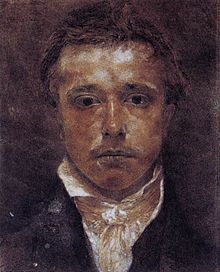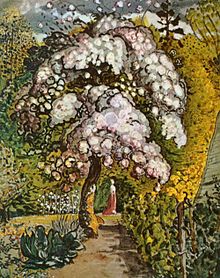Samuel Palmer
Samuel Palmer (born January 27, 1805 in Newington near London , † May 24, 1881 in Redhill , Surrey , England ) was a British landscape painter , draftsman and etcher of the Romantic era .
Life
As the son of a bookseller, Palmer began studying literature and painting as a child . He received his first instruction from the landscape painter William Wate, and as early as 1819 his works were exhibited in the Royal Academy of Arts and by the British Institution. After his family moved to the London borough of Bloomsbury in 1820, he was able to make drawings based on ancient statues in the British Museum. In 1822 he became friends with John Linnell and learned through this his teacher John Varley , William Mulready and especially William Blakewhose visionary and mystical works exerted a strong influence on Palmer, as can be seen in the early painting Repose of the Holy Family (1824), but also in his melancholy self-portrait from 1824/25, executed in colored chalk.
At that time he joined a group of painters friend who called themselves "The Ancients", who were influenced by spiritualism , pantheism and Neoplatonism and to whom u. a. Edward Calvert and George Richmond belonged to. In 1827 the artist's father moved to Shoreham in the county of Kent , where he stayed until 1835, and the characteristics of the landscape there are reflected in Palmer's paintings from those years. Among the more important works of this period are Bright Cloud and Skylark , which the artist executed in oil like other of his early works . However, the move to London in 1835 resulted in an increasingly naturalistic conception of landscape.
After Palmer had married Hannah Linnell, a daughter of John Linnell, in 1839, his honeymoon took him to Italy, where he studied painting for two years and increasingly turned to painting with watercolors . As a result, his works also experienced a change in style. Instead of depicting night scenes as in the past, he now devotes himself to more academic, conventional, light-flooded classic motifs.
After his return to England in 1840, he became an associate member in 1843, then in 1854 a member of the Royal Watercolor Society . His watercolors are characterized by an excellent representation of landscape forms and by the masterful use of rich, light and at the same time striking colors. Some of the best and most important images Palmer created during these years include the illustrations for reissues of John Milton's books L'Allegro and Il Penseroso .
In 1853 he was also elected a member of the English Etching Club and from then on also devoted himself to the art of etching . Despite his advances in this technique, the number of etchings in his oeuvre is small. They are characterized by truthfulness and completeness in their tonality and combine numerous features of other graphic techniques, such as mezzotint and woodcut . Etchings such as Early Plowman and Herdman's Cottage also appeared in the textbook Etching and Etchers .
Since his works were selling poorly overall, Palmer was forced to move to Redhill in Surrey in 1862 , where the artist made contact with the Pre-Raphaelites and died in 1881. His last work included a series of etchings illustrating an English-language edition of Virgil's Eclogae published in 1883. In addition to etchings, this also contained reproductions of his watercolor paintings. Some of the etchings contained in this volume were completed by his son, AH Palmer.
In the following decades, Palmer and his works fell largely into oblivion. It was only rediscovered during the Second World War by neo-romantic painters such as Paul Nash , Graham Sutherland and John Minton , who saw something essentially English in his works with surrealistic overtones.
literature
- Geoffrey Grigson: Samuel Palmer: The Visionary Years . London: Kegan Paul, 1947
- Raymond Lister (Ed.): The Letters of Samuel Palmer . 2 volumes. Oxford: Clarendon Press, 1974
- Raymond Lister: Samuel Palmer, A Biography . London: Faber and Faber, 1974
- Raymond Lister: Catalog Raisonné of the Works of Samuel Palmer . Cambridge: Cambridge University Press, 1988
- Colin Harrison, William Vaughan, Elizabeth E. Barker, et al. a .: Samuel Palmer 1805-1881. Vision and Landscape . Exhibition cat. British Museum, London, and Metropolitan Museum, New York, 2005
- Rachel Campbell-Johnston: Mysterious Wisdom: The Life and Work of Samuel Palmer , London; Berlin [u. a.]: Bloomsbury, 2011, ISBN 978-0-7475-9587-8
- William Vaughan: Samuel Palmer: Shadows on the Wall . New Haven and London: Yale University Press, 2015
Web links and sources
- Literature by and about Samuel Palmer in the catalog of the German National Library
- Samuel Palmer in nndb (English)
- Chambers Biographical Dictionary, Edinburgh 2002, ISBN 0-550-10051-2 , p. 1162
- Meyers Großes Personenlexikon , Mannheim 1968, p. 994
Web links
| personal data | |
|---|---|
| SURNAME | Palmer, Samuel |
| BRIEF DESCRIPTION | British Romantic painter and etcher |
| DATE OF BIRTH | January 27, 1805 |
| PLACE OF BIRTH | London |
| DATE OF DEATH | May 24, 1881 |
| Place of death | Newington near London |



